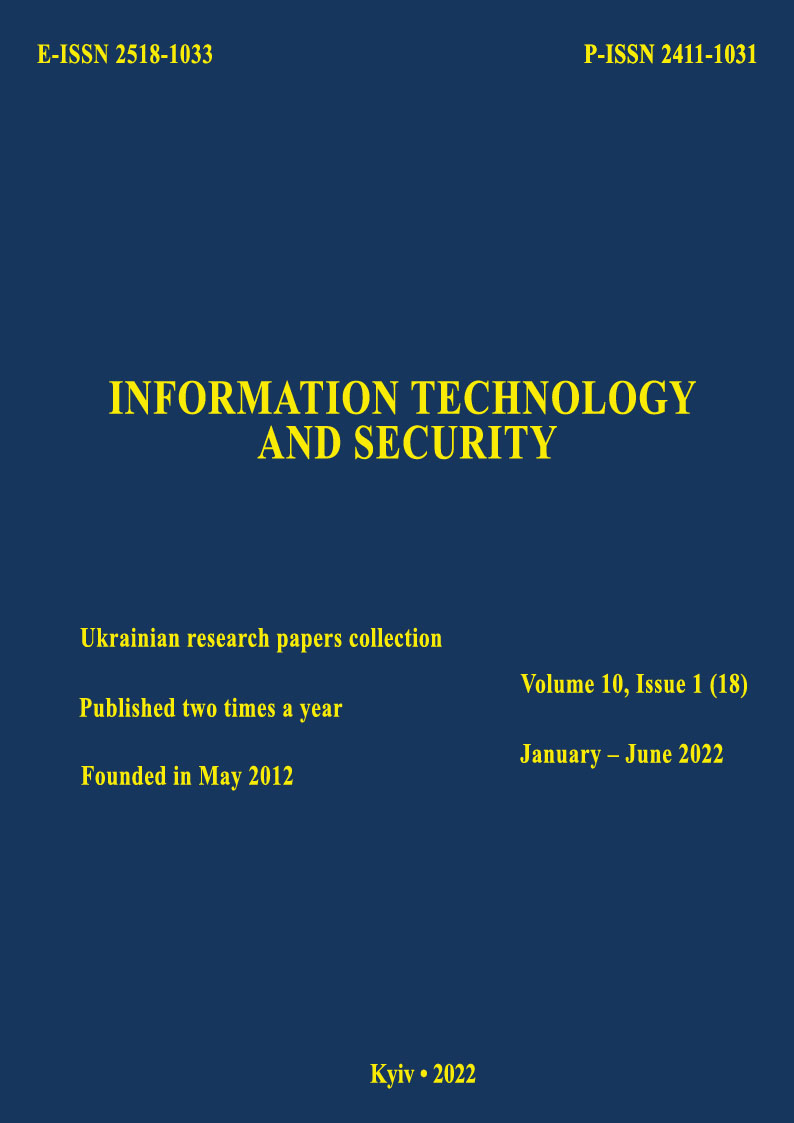Method of designing the system of classes of the subject area model on the basis of the architecture of integrated objects
DOI:
https://doi.org/10.20535/2411-1031.2022.10.1.261040Keywords:
design of classes, decapsulation, subject area modelAbstract
The article presents a method of designing the system of software classes, which includes the stages of conceptual, logical and physical design of classes with the implementation of a software system in the architecture of integrated objects. The input data for design is the model of the subject area, which is obtained as the result of object-oriented analysis, which is represented by conceptual, mathematical and semantic models. The conceptual model defines the entities and attributes of entities and is considered as the basis for designing the properties of classes. Mathematical model, as a dynamic model of entity behavior, is formally or informally defined by mathematical formulas, algorithms, diagrams or descriptions of the implementation, which is the basis for designing class methods. The semantic model defines the concepts of subject area in relation to the elements of its model and includes identifiers, meaningful names and descriptions used for the design, programming and implementation of system functionality in terms of subject area. The proposed design method is based on the following principles: normalization of classes (reduction of data to atomic values, reduction of class methods arguments and removal of redundant class methods), replacement of inheritance by logical composition and physical integration, decapsulation (separation of physical functional model from logical data model), virtualization of classes (logical model of classes are considered as a set of relational data model and physical functional model of class methods), interrelation of models (end-to-end mapping of conceptual model on logical and physical model, and class implementation). The essence of the method is to perform successive stages of design: normalization of conceptual model, logical design of classes (transformation of mathematical model into normalized functional model, design and analysis of class characteristics), physical design of classes in architecture of integrated objects (creation of classes, mapping of logical classes on physical classes, implementation of classes in programming language). Actually, the developed design method leads to the creation of a model focused on solving problems, when instances of entities are not created entirely and only the properties and methods that are needed to calculate the desired results for given input values are used. An example of application of the method for a certain subject area with demonstration of design results is considered, and also the approach on the basis of query language of formulation of problems in terms of subject area with generation of source code in programming language is shown. The application of the method allows to increase the efficiency of creating software systems due to the non-redundancy of the system of classes and parameters of class methods, reuse of code and selection of the minimum required set of properties and class methods when solving specific problems.
References
V. Sokolov, “Architecture of software based on integrated objects”, Information Technology and Security, vol. 5, no. 2, pp. 51-59, July-December 2017, doi: https://doi.org/10.20535/2411-1031.2017.5.1.120559.
V. Sokolov, “Application of functional and relational models in object-oriented programming”, Information Technology and Security, vol. 5, no. 1, pp. 54-63, January-June 2017, doi: https://doi.org/10.20535/2411-1031.2017.5.1.120559.
F. Ciccozzi, I. Malavolta, and B. Selic, “Execution of UML models: a systematic review of research and practice”, Software & Systems Modeling, vol. 18, no. 18, pp. 2313-2360, 2019, doi: https://doi.org/10.1007/s10270-018-0675-4.
T. Buchmann, and A. Rimer, “Unifying Modeling and Programming with ALF”, in Proc. 2nd International Conference on Advances and Trends in Software Engineering (SOFTENG 2016), Lisbon, Portugal, 2016, pp. 10-15.
Zhang, Weixin, and Bruno Oliveira. “Shallow EDSLs and Object-Oriented Programming: Beyond Simple Compositionality”, The Art, Science, and Engineering of Programming, vol. 3, no. 3, article 10, 2019, doi: https://doi.org/10.22152/programming-journal.org/2019/3/10/.
Sabah Al-Fedagh, “Classes in Object-Oriented Modeling (UML): Further Understanding and Abstraction”, IJCSNS International Journal of Computer Science and Network Security, vol. 21, no. 5, pp. 139-150, May 2021, doi: https://doi.org/10.48550/arXiv.2106.00267.
Du, et al., “COSPA: Identifying Key Classes in Object-Oriented Software Using Preference Aggregation”, IEEE Access, vol. 9, pp. 114767-114780, 2021, doi: https://doi.org/10.1109/ACCESS.2021.3105475.
T. Kovaliuk, and N. Kobets, “The Object Model of the Subject Domain with the Use of Semantic Networks”, in Proc. 3rd International Conference on Computational Linguistics and Intelligent Systems (COLINS 2019), Kharkiv, Ukraine, vol. 2362, 2019, pp. 228-242.
Le, Duc Minh, Duc-Hanh Dang, and Viet-Ha Nguyen, “Generative software module development for domain-driven design with annotation-based domain specific language”, Information and Software Technology, vol. 120, 2020, doi: https://doi.org/10.1016/j.infsof.2019.106239.
Le, Duc Minh, Duc-Hanh Dang, and Viet-Ha Nguyen, “On domain driven design using annotation-based domain specific language”, Computer Languages, Systems & Structures, vol. 54, pp. 199-235, 2018, doi: https://doi.org/10.1016/j.cl.2018.05.001.
Downloads
Published
How to Cite
Issue
Section
License
Copyright (c) 2022 Collection "Information Technology and Security"

This work is licensed under a Creative Commons Attribution 4.0 International License.
The authors that are published in this collection, agree to the following terms:
- The authors reserve the right to authorship of their work and pass the collection right of first publication this work is licensed under the Creative Commons Attribution License, which allows others to freely distribute the published work with the obligatory reference to the authors of the original work and the first publication of the work in this collection.
- The authors have the right to conclude an agreement on exclusive distribution of the work in the form in which it was published this anthology (for example, to place the work in a digital repository institution or to publish in the structure of the monograph), provided that references to the first publication of the work in this collection.
- Policy of the journal allows and encourages the placement of authors on the Internet (for example, in storage facilities or on personal web sites) the manuscript of the work, prior to the submission of the manuscript to the editor, and during its editorial processing, as it contributes to productive scientific discussion and positive effect on the efficiency and dynamics of citations of published work (see The Effect of Open Access).

